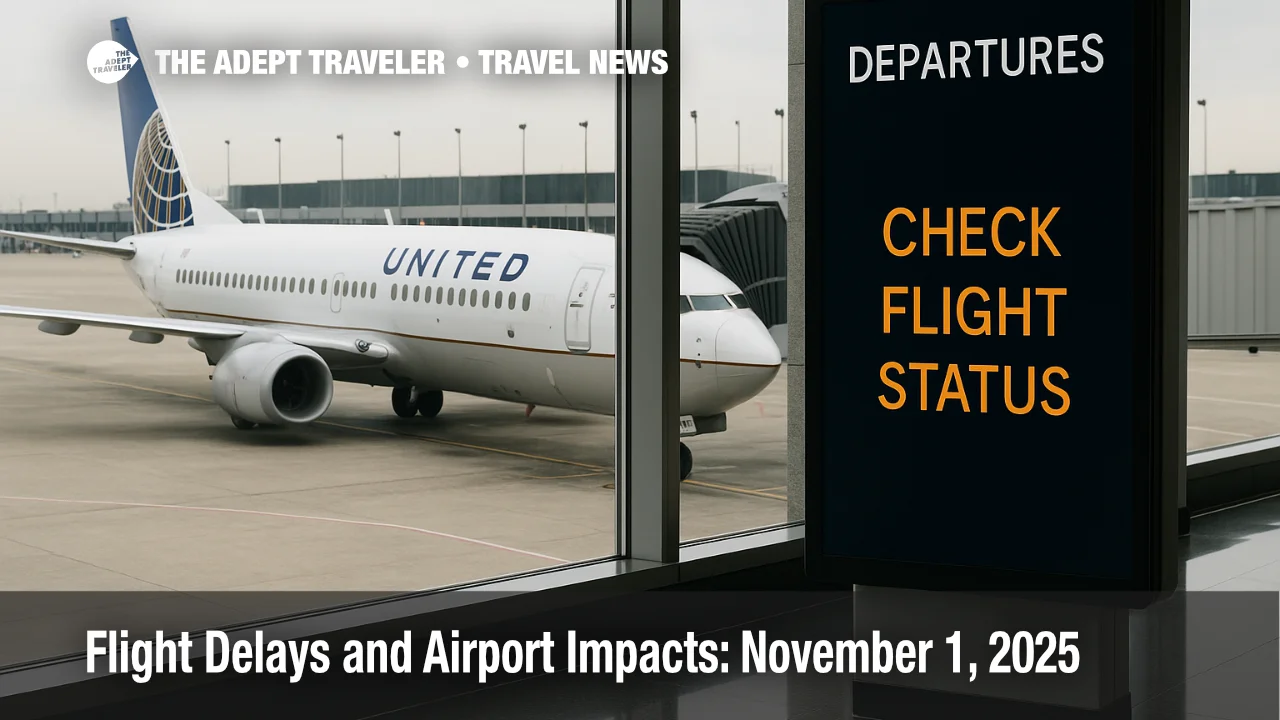Flight Delays and Airport Impacts: November 1, 2025

Key points
- FAA command center has not issued a formal Operations Plan Advisory yet this morning but is adjusting programs as needed
- Staffing shortages tied to the federal shutdown continue to elevate the risk of ground stops and delays at major facilities
- Weather features include pockets of low ceilings and gusty winds, which could trigger arrival and departure rate cuts at coastal and Great Lakes hubs
Impact
- Expect Longer Taxi Times
- Metering and reduced airport acceptance rates may add 30-90 minutes at the worst affected hubs
- Build Connection Buffers
- Avoid tight layovers under 60 minutes today and monitor gate changes in the app
- Verify Waivers And Options
- Airlines may allow free same-day changes when FAA programs or severe weather materially affect your flight
- Arrive Earlier Than Usual
- Plan to reach the airport 30 minutes earlier than normal if departing from a Level 1 or Level 2 delay hub
- Watch Late-Day Ripples
- Evening flights can inherit afternoon delays when ground delay programs extend, so recheck status after 2:00 p.m. local
The Federal Aviation Administration's Air Traffic Control System Command Center is managing routine traffic flows on Saturday, November 1. As of early morning Central Time, the Command Center has not issued a standing, narrative Operations Plan Advisory, which indicates a relatively normal start, although targeted initiatives are still applied as needed to balance demand and capacity at individual facilities. Travelers should continue to check airline apps for gate and schedule changes and allow extra time where programs are active.
FAA picture this morning
The FAA's public dashboard for the National Airspace System shows active airport events that are updated throughout the day, including ground delay programs, arrival or departure rate adjustments, and any ground stops in effect. This page is the authoritative, live snapshot to confirm whether your origin or destination is subject to metering, flow restrictions, or weather holds.
In parallel, the daily Air Traffic Report page explains how the agency summarizes anticipated impacts and how those expectations can change as weather evolves. While the page's last formal newsroom update lags, the operational status remains governed by the live Command Center advisories and the NAS dashboard noted above. The practical takeaway for travelers is to trust the live NAS page and airline apps over static summaries when making go, no go, or rebooking choices.
Latest developments
Two forces remain in play beyond localized weather. First, controller staffing continues to be tight during the ongoing federal shutdown, which has periodically driven short-notice ground stops and throughput reductions at major hubs this week. Several newsrooms reported elevated staffing "triggers," with delays observed at busy airports on Friday and in prior days, underscoring the potential for knock-on effects today if facilities run short or weather degrades. Travelers should treat these as risk factors, not certainties, and watch for Command Center advisories that may appear with little lead time.
Second, weather remains a variable. The National Weather Service's prediction charts for November 1 flag areas of unsettled conditions that can translate into low ceilings, visibility reductions, and wind constraints around parts of the coasts and the Great Lakes. Even modest shifts in ceiling height or crosswinds can force rate cuts that propagate delays into the afternoon push and evening bank at connecting hubs.
Analysis
What this means for your day is straightforward. If your itinerary touches a coastal airport or a busy inland connector, assume there may be episodic metering, particularly during the late morning and mid-afternoon pushes, when demand peaks. Rate-reduction programs tend to create uneven delays, with some banks moving on time and the next wave slipping by 30-90 minutes as controllers and airlines absorb constraints. Because the Command Center had no umbrella Operations Plan Advisory posted early this morning, disruptions, if they occur, are more likely to be localized and time-boxed rather than national in scope.
Background The Air Traffic Control System Command Center, ATCSCC, manages traffic by issuing tools like ground delay programs that meter arrivals into constrained airports, as well as ground stops when safety or capacity requires a brief pause. These initiatives are published to the NAS status dashboard and, when warranted, in narrative Operations Plan Advisories. The absence of a narrative advisory does not preclude targeted programs, it simply means the Command Center does not see a need for a nationwide plan at that moment. Travelers should always verify their specific flight status in the airline app after the FAA posts a new program.
Final thoughts
Today's Flight Delays and Airport Impacts hinge on live, local programs rather than a nationwide plan. Use the FAA NAS status page to confirm active initiatives and your airline app to execute changes, then budget extra time at known peak banks. That combination remains the most reliable way to stay ahead of rolling delays on November 1.
Sources
- FAA, ATCSCC Current Operations Plan Advisory, November 1, 2025
- FAA, National Airspace System Status, live events list
- FAA, Daily Air Traffic Report explainer
- NOAA, Weather Prediction Center forecast tools for November 1
- Reuters, staffing-related disruption risk during shutdown, November 1
- Associated Press, LAX ground stop during staffing shortfall, October 26
